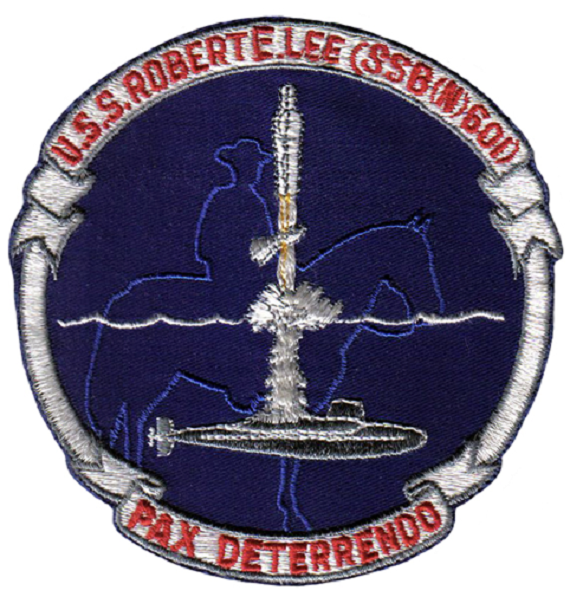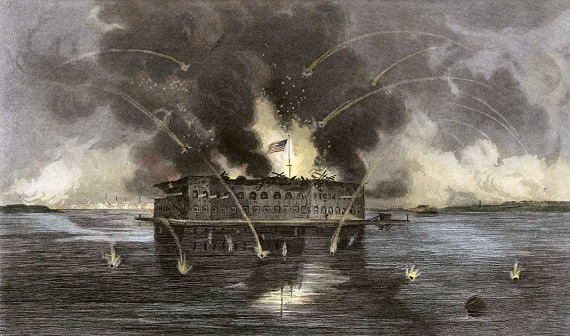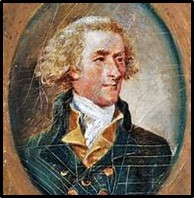Over half a century before the Imperial German Navy launched its new and deadly method of undersea warfare against the Allied navies and merchant shipping in World War One, the Confederate Army was making history’s first successful submarine attack on an enemy warship. On the night of February 17, 1864, First Lieutenant George E. Dixon, a former steamboat engineer before enlisting in the Confederate Army, and a crew of seven volunteers propelled their submersible vessel, the “H. L. Hunley,” toward its target. Their prey was the Union’s powerful new sloop-of-war, the “USS Housatonic,” the primary warship then blockading Charleston Harbor.
The “Hunley’s” spar torpedo hit its mark and tore a huge hole in the starboard hull of the twelve-hundred-ton Union vessel that caused the ship to sink within five minutes. The attack took with it five of the Housatonic’s one hundred sixty crew members. The explosion also damaged the “Hunley” and ultimately sank the submarine before it could return to its base in Breach Inlet on Sullivan’s Island at the entrance to Charleston Harbor. The vessel and all its crew were to remain lost in the deep waters off the Charleston shore for more than a hundred thirty years.
Even though Dixon and the “Hunley” had attacked and sunk a United States warship during the War, a century later the U. S. Navy saw fit to name one of its submarine tenders the “USS Hunley.” The ship was not named for the vessel, but in honor of Horace Lawson Hunley, the New Orleans planter who had designed and built the Confederate submarine and then bravely died testing it in October of 1863. A decade after the “USS Hunley” was commissioned, Lieutenant George Dixon was also honored by the U. S. Navy when they named another of their submarine tenders after him in 1971.
Fortunately, both the “USS Hunley” and “USS Dixon” were decommissioned in the mid-1900s and can no longer be part of the insane anti-Confederate craze that is now sweeping the nation. Oddly enough, after being taken out of active service, the “USS Dixon” was used as a target ship in training exercises and was sunk off Charleston in 2003, just eight years after the hulk of the long lost “H. L. Hunley” had finally been discovered in the nearby depths. These, however, were not the only U. S. Navy vessels to be named for Confederates and other Southerners whose names are now in the process of being erased from the pages of American history.
Such naming also held true for a number of the other Navy warships that are no longer in service, including four guided missile destroyers and a missile-equipped frigate. The first of those destroyers was the “USS Buchanan” that was commissioned in 1942 and named for Admiral Franklin Buchanan who commanded the Confederacy’s first ironclad, the “CSS Virginia,” in the historic battle of Hampton Roads. Next was the “USS Semmes” that went into service twenty years later and was named for Confederate Rear Admiral Raphael Semmes, the commander of the famed and feared “CSS Alabama.” The following year, the “USS Waddell” was commissioned in honor of Commander James Waddell whose raider, the “CSS Shenandoah,” wreaked havoc on Northern shipping in the Pacific and was the last Confederate ship to surrender. The “USS Tattnall” that was also commissioned in 1963 was named for Commodore Josiah Tattnall who led the Confederate naval forces guarding the coasts of Georgia and South Carolina.
The last of these vessels was the frigate “USS Richard L. Page.” That ship was commissioned in 1967 and named for a man who was both a Confederate Navy captain and later an Army brigadier general. When Virginia seceded from the Union, Page, a former commander in the U. S. Navy, became the naval aide to Governor John Letcher and was placed in charge of constructing river defenses in the tidewater area. Page then joined the Confederate Navy in late 1861 and commissioned a captain. He was later assigned to Admiral Tattnall’s squadron where he was given command of the ironclad “CSS Savannah.” Page left the Navy for the Army in 1864, was commissioned a brigadier general and placed in charge of the fortifications defending Mobile Bay in Alabama.
Aside from these seven surface vessels with Confederate names, as well as the six U. S. Navy ships of various types named for Matthew Fontaine Maury dating back to World War One, there were three other vessels that would undoubtedly draw even greater excoriation from today’s so-called “social justice warriors.” These would be the three that were among the forty-one “George Washington” and “James Madison” Class Polaris ballistic missile submarines that were launched and named during the time of Admiral Hyman G. Rickover, the “Father of the Nuclear Navy.” These boats were the “USS Robert E. Lee,” “USS Stonewall Jackson” and “USS John C. Calhoun.”
In his 1972 book, “Eminent Americans: Namesakes of the Polaris Submarine Fleet,” Admiral Rickover presented an essay on each of the forty-one individuals whose names were selected for that undersea fleet. In the book’s preface, Rickover had the prescience to write, “Today, it is more important than ever that high officials and the institutions in their charge set the moral tone for our people. Contributing to this need is the lessening in religious convictions—many seeing the world as fulfilling today what in the past was promised for Heaven—and the decline of the Protestant Ethic of work. If the present trend is to be arrested and corrected we must have more leaders who set the moral tone and example for our people. . .” and Rickover then cited that such needed men were those like Washington, Adams, Jefferson and Madison, and included in his list were Lee, Jackson and Calhoun as well.
Rickover’s preface then went on to predict with unerring accuracy that, “Unless this takes place, we will increasingly become a fragmented Nation, each interest group attempting to use the national patrimony for its own good rather than for the Nation as a whole. The lives of the Americans described in these essays may offer insights into how we may once again feel a sense of unity of interest.” To Admiral Rickover, as to the Navy itself in those days, the primary criteria for the naming of a vessel was a person’s honor, valor and a sense of morality, as well as their military acumen, regardless of which side of the Mason-Dixon Line such individuals might have served at some point in their lives.
In line with this, I reached out to a retired Navy commander with over thirty years of active service for his comments on the renaming of Navy vessels. This former officer, who now lives in Florida, had served not only aboard the “USS Dixon” but also on submarines in Admiral Rickover’s Polaris fleet and his thoughts on the matter were most trenchant. He wrote me,“In my naval career, I have never heard anyone complain about a ship’s name. Typically, people were quite proud of the names of their ships or submarines and knew the history of the individuals after whom they were named. I am also certain that people currently in the service have no issue with the names of their vessels.” He further noted that as only a little over seven per cent of Americans living today have ever seen military service, the probability is that the people who now take issue with the Confederate names of Army bases and Navy ships have never served in the military. The only exception to the latter, I should add, would be the pitiful cadre of high-ranking military brass who have now seen fit to join forces with the “social justice warriors” for personal or political gain.
Today, however, these wretched “warriors” would have us believe a very different story. At present, there are only two ships that have drawn their attention and have now been placed on the list of “names, symbols, displays, monuments and paraphernalia” to be erased and replaced by the newly created congressional and DOD monstrosity, the “Commission on the Naming of Items of the Department of Defense that Commemorate the Confederate States of America or Any Person Who Served Voluntarily with the Confederate States of America.”
One of these ships, the Ticonderoga Class guided-missile cruiser “USS Chancellorsville,” was commissioned in 1989. The second is the much newer “USNS Maury,” an oceanographic survey ship that went into service five years ago. While the “Maury,” the latest of the six ships honoring Matthew Fontaine Maury, was christened for someone who served in the Confederate Navy, the renaming of the “Chancellorsville” is really a bit of a stretch. All twenty-seven Ticonderoga Class warships were named after famous battles in American history, with six of these being from the War Between the States. The “Chancellorsville,” however, is the only one named for an overwhelming Confederate victory hence its relegation to history’s dustbin.
As to the “Maury,” even though the “Father of Modern Oceanography” did offer his services to the South during the War, Maury engaged in no actual fighting. In fact, he spent much of the War on diplomatic missions in Europe, as well as acquiring one ship for the Confederacy, the British merchant steamer “Japan” that was later armed and renamed the “CSS Georgia.” Moreover, Maury’s contribution to America’s progress as an astronomer, author, educator, historian, oceanographer, meteorologist, cartographer and geologist both prior to and after the War far outweigh whatever he might have contributed to the Confederacy.
As a final point, one should also be aware of Admiral Hyman Rickover’s personal history in order to properly judge his perspective regarding those men about whom he wrote. Rickover, who was born into a poor Jewish family in then Russian-dominated Poland, was certainly no stranger to prejudice and persecution. As a Jewish child in Poland, he would have been forbidden from attending any public schools. However, even after his family immigrated to America in 1906, he soon discovered that virulent anti-Semitism was also rampant in his new homeland. While young Rickover was able to go to school in America, he always found that the specter of religious prejudice haunted each of his classrooms even those at the U. S. Naval Academy. Rickover, however, managed to rise above such persecution and became one of America’s most influential and respected military leaders and innovators.
Many individuals from our nation’s past are now being castigated as irredeemable racists and traitors to their country by the uninformed and misled rabble that has no real understanding of America’s history or heritage. Even more unfortunate is the sad fact that this also holds true for a majority of those in Congress, as well as those now holding sway in the Department of Defense. Such people should instead take a page from Admiral Rickover’s book. Rather than being filled with an unreasoning anger and a mindless feeling of hatred towards once well-respected individuals in our nation’s past, they should, like Rickover, weigh the overall character of men such as those for whom his submarines were named and then judge them far more for what they have added to America’s greatness than for what they might possibly have subtracted from it.








Thanks John Marquardt for this history of the Confederate named US Navy vessels. The time of Southerners being able to honor our heroes and ancestors are over. It’s heartbreaking and disturbing knowing that there is very little, if any, political support. I’m glad that you mentions Matthew F. Maury. I know must Southerners would not know who he was, but he was a Confederate nonetheless. I mention him because the Navy Base that I work at has a building named after him. The new Commanding Office does not want his name on letterheads and other media.